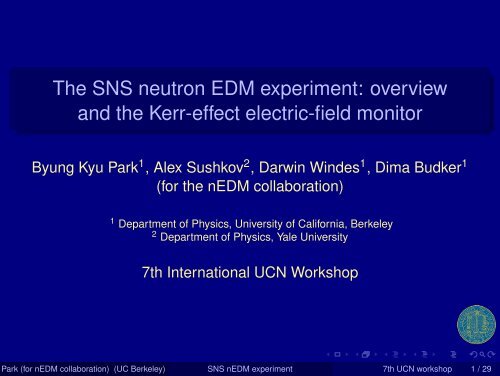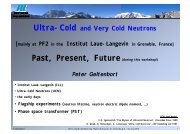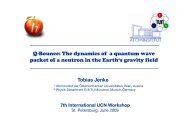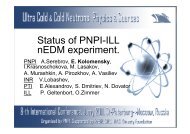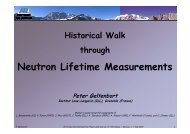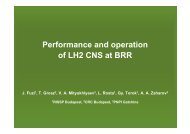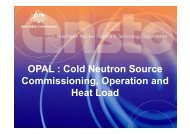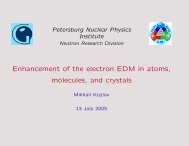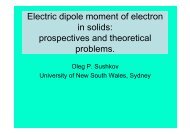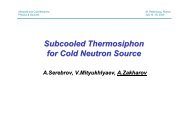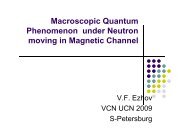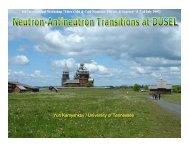The SNS neutron EDM experiment - 8th International UCN ...
The SNS neutron EDM experiment - 8th International UCN ...
The SNS neutron EDM experiment - 8th International UCN ...
You also want an ePaper? Increase the reach of your titles
YUMPU automatically turns print PDFs into web optimized ePapers that Google loves.
<strong>The</strong> <strong>SNS</strong> <strong>neutron</strong> <strong>EDM</strong> <strong>experiment</strong>: overviewand the Kerr-effect electric-field monitorByung Kyu Park 1 , Alex Sushkov 2 , Darwin Windes 1 , Dima Budker 1(for the n<strong>EDM</strong> collaboration)1 Department of Physics, University of California, Berkeley2 Department of Physics, Yale University7th <strong>International</strong> <strong>UCN</strong> WorkshopPark (for n<strong>EDM</strong> collaboration) (UC Berkeley) <strong>SNS</strong> n<strong>EDM</strong> <strong>experiment</strong> 7th <strong>UCN</strong> workshop 1 / 29
Outline1 <strong>The</strong> <strong>SNS</strong> n<strong>EDM</strong> <strong>experiment</strong>: an overview2 <strong>The</strong> <strong>SNS</strong> n<strong>EDM</strong> <strong>experiment</strong>: current progress3 Kerr-effect electric field monitorPark (for n<strong>EDM</strong> collaboration) (UC Berkeley) <strong>SNS</strong> n<strong>EDM</strong> <strong>experiment</strong> 7th <strong>UCN</strong> workshop 2 / 29
State of the <strong>neutron</strong> <strong>EDM</strong>Currently: |d n| < 2.9 × 10 −26 e · cm, Baker et al., PRL 97, 131801 (2006)Summary of current and expected <strong>experiment</strong>al limits on n<strong>EDM</strong> aCP violation instandard model (fromK 0 decay) not enoughto explain amount ofmatter in universeStringent limit onextensions to thestandard modelConstrain or verifysupersymmetrypredictions in nearfuturea Lamoreaux and Golub, “<strong>The</strong> Neutron Electric Dipole Moment: Yesterday,Today, and Tomorrow” in Lepton Dipole Moments, ed. Roberts & Marciano, 2009Park (for n<strong>EDM</strong> collaboration) (UC Berkeley) <strong>SNS</strong> n<strong>EDM</strong> <strong>experiment</strong> 7th <strong>UCN</strong> workshop 3 / 29
State of the <strong>neutron</strong> <strong>EDM</strong>Currently: |d n| < 2.9 × 10 −26 e · cm, Baker et al., PRL 97, 131801 (2006)Summary of current and expected <strong>experiment</strong>al limits on n<strong>EDM</strong> aCP violation instandard model (fromK 0 decay) not enoughto explain amount ofmatter in universeStringent limit onextensions to thestandard modelConstrain or verifysupersymmetrypredictions in nearfuturea Lamoreaux and Golub, “<strong>The</strong> Neutron Electric Dipole Moment: Yesterday,Today, and Tomorrow” in Lepton Dipole Moments, ed. Roberts & Marciano, 2009Park (for n<strong>EDM</strong> collaboration) (UC Berkeley) <strong>SNS</strong> n<strong>EDM</strong> <strong>experiment</strong> 7th <strong>UCN</strong> workshop 3 / 29
<strong>SNS</strong> <strong>experiment</strong>: distinguishing features<strong>UCN</strong> production by “superthermal” method 1 with ultrapuresuperfluid 4 He and storage in the same cell<strong>UCN</strong> storage within the helium volume:Gain in <strong>neutron</strong> density by at 2 orders of magnitudes from previous<strong>experiment</strong>sLHe is good dielectric → higher applied electric field by factor of 4Use of 3 He:as polarizer: selectively absorbs antialigned <strong>neutron</strong>s; improves<strong>neutron</strong> polarization from 90% to 95%as comagnetometer: precesses under B field and sees the samefield as <strong>neutron</strong>s; control systematics related to magnetic fieldsas <strong>neutron</strong> detector: if <strong>neutron</strong> is absorbed, <strong>neutron</strong> wasanti-aligned; if it is not absorebd, it was aligned1 Golub and Pendlebury, Phys. Lett. A 62, 337 (1977)Park (for n<strong>EDM</strong> collaboration) (UC Berkeley) <strong>SNS</strong> n<strong>EDM</strong> <strong>experiment</strong> 7th <strong>UCN</strong> workshop 4 / 29
<strong>EDM</strong> sensitivity: statisticsPark (for n<strong>EDM</strong> collaboration) (UC Berkeley) <strong>SNS</strong> n<strong>EDM</strong> <strong>experiment</strong> 7th <strong>UCN</strong> workshop 5 / 29
<strong>EDM</strong> sensitivity: statistics∆EΩ L= −⃗µ·⃗B= γ B BPark (for n<strong>EDM</strong> collaboration) (UC Berkeley) <strong>SNS</strong> n<strong>EDM</strong> <strong>experiment</strong> 7th <strong>UCN</strong> workshop 5 / 29
<strong>EDM</strong> sensitivity: statistics∆E + δE= −⃗µ·⃗B − ⃗ d·⃗EΩ L ± δΩ L = γ B B ± γ E EIf state of n completely specified byexisting quantum numbers, ⃗ d ‖ ⃗µPark (for n<strong>EDM</strong> collaboration) (UC Berkeley) <strong>SNS</strong> n<strong>EDM</strong> <strong>experiment</strong> 7th <strong>UCN</strong> workshop 5 / 29
<strong>EDM</strong> sensitivity: statistics∆E + δE= −⃗µ·⃗B − ⃗ d·⃗EΩ L ± δΩ L = γ B B ± γ E EIf state of n completely specified byexisting quantum numbers, ⃗ d ‖ ⃗µSensitivity: δΩ L ∝1E √ NτT<strong>The</strong> <strong>SNS</strong> <strong>experiment</strong>:E ≈ 50 kV/cmN ≈ 150 per cm 3 × 3000 cm 3τ ≈ 500 s for each measurementT ≈ 300 live days for initial duration ofthe <strong>experiment</strong>2π × δΩ L ≈ 2.6 µHzHigh electric field and density madepossible by keeping <strong>neutron</strong>s insuperfluid heliumHigh voltage (≈ 500 kV) is producedwithout an actual high voltage supply withgain capacitorsPark (for n<strong>EDM</strong> collaboration) (UC Berkeley) <strong>SNS</strong> n<strong>EDM</strong> <strong>experiment</strong> 7th <strong>UCN</strong> workshop 5 / 29
<strong>EDM</strong> sensitivity: systematics⃗v × ⃗ E effectFor bottled <strong>UCN</strong>, only quadraticdynamic phase—linear geometricphase may remainmagnetic field fluctationcorrect with 3 He signalpseudomagnetic field in thepresence of polarized 3 Hesignificant but canceled withtwo-cell designgeometric phase aoccurs with B field inhomogeneitydoesn’t cancel between 3 He and ntemperature-dependentFrom Conceptual Design Report for the n<strong>EDM</strong> Projecta Commins. Am. J. Phys. 59, 1077 (1991),Pendlebury et al. Phys. Rev. A 70, 032102 (2004)Park (for n<strong>EDM</strong> collaboration) (UC Berkeley) <strong>SNS</strong> n<strong>EDM</strong> <strong>experiment</strong> 7th <strong>UCN</strong> workshop 6 / 29
<strong>SNS</strong> n<strong>EDM</strong> <strong>experiment</strong>: <strong>UCN</strong> sourceBeamline from <strong>SNS</strong>Superthermal production of <strong>UCN</strong> ain ultrapure superfluid 4 He at 0.5 Kfinal <strong>neutron</strong> temperature: 3 mKa Golub and Pendlebury, Phys. Lett. A 62, 337 (1977)Park (for n<strong>EDM</strong> collaboration) (UC Berkeley) <strong>SNS</strong> n<strong>EDM</strong> <strong>experiment</strong> 7th <strong>UCN</strong> workshop 7 / 29
<strong>SNS</strong> n<strong>EDM</strong> <strong>experiment</strong>: 3 He comagnetometercomagnetometers:measure local magneticfield fluctuationsHg comagnetometerssuccessfully used before3 He occupy samevolume as <strong>neutron</strong>s insuperfluid 4 He: idealcomagnetometer for<strong>SNS</strong> <strong>experiment</strong>3 He precession signaldetected byexternally-placedSQUIDsHarris et al., Phys. Rev. Lett. 82, 904 (1999)Park (for n<strong>EDM</strong> collaboration) (UC Berkeley) <strong>SNS</strong> n<strong>EDM</strong> <strong>experiment</strong> 7th <strong>UCN</strong> workshop 8 / 29
<strong>SNS</strong> n<strong>EDM</strong> <strong>experiment</strong>: 3 He <strong>neutron</strong> detectorn + 3 He → p + 3 H + 764 keVreaction products produce UV scintillation light (80 nm) in the LHe 2UV scintillation light down-shifted (430 nm) and detectedgreater cross section (by factor of 200) in the singlet statemeasures beat frequency between Ω L, 3 He and Ω L,n (small becausegyromagnetic ratio is the same within 10%)Figure from W. Korsch’s talk at PANIC08, “<strong>The</strong> <strong>SNS</strong> Neutron <strong>EDM</strong> Experiment”2 Doyle and Lamoreaux, Europhys. Lett. 26, 253 (1994)Park (for n<strong>EDM</strong> collaboration) (UC Berkeley) <strong>SNS</strong> n<strong>EDM</strong> <strong>experiment</strong> 7th <strong>UCN</strong> workshop 9 / 29
<strong>SNS</strong> n<strong>EDM</strong> <strong>experiment</strong>: 3 He <strong>neutron</strong> detectorOptimization of initial 3 He and n angleCalculation by Pinghan Chu for n<strong>EDM</strong> collaborationChange in Ω L,n without change inΩ L, 3 He → n<strong>EDM</strong>3 He has negligible <strong>EDM</strong>:d199 Hg < 10−28 e · cm, and <strong>EDM</strong> ofdiamagnetic atom varies as Z 2Dressed spin technique amodify effective gyromagnetic ratiowith oscillating B field so thatγ n ′ = γ ′3 He(critical dressing)optimize sensitivity to d n byappropriate choice of initial angle:as much as a factor of 2 increasein sensitivitya Golub and Lamoreaux, Phys. Rep. 237, 1 (1994)Park (for n<strong>EDM</strong> collaboration) (UC Berkeley) <strong>SNS</strong> n<strong>EDM</strong> <strong>experiment</strong> 7th <strong>UCN</strong> workshop 10 / 29
<strong>SNS</strong> n<strong>EDM</strong> <strong>experiment</strong>: Measurement Cycle1 Diffuse polarized 3 He atoms into themeasurement cell2 Illuminate the measurement cell with polarizedcold <strong>neutron</strong>s to produced polarized <strong>UCN</strong>aligned with the 3 He atoms3 Apply π/2 pulse to rotate spins to beperpendicular to the magnetic field4 Make precession frequency measurements5 Remove 3 He atoms from the cryostats bydiffusion to the purifier6 Reload the collection volume with polarized 3 Hefrom the ABS7 Return to step 1100 sec1000 sec10 sec500 sec100 sec(300 sec,during othersteps)Park (for n<strong>EDM</strong> collaboration) (UC Berkeley) <strong>SNS</strong> n<strong>EDM</strong> <strong>experiment</strong> 7th <strong>UCN</strong> workshop 11 / 29
<strong>SNS</strong> n<strong>EDM</strong> Experiment: progressBasic R&D done, including:valve test: 10,000 cycles without failure3 He relaxation time: measured at Duke and UIUC; results agreeand meet project requirement<strong>UCN</strong> storage time: 300 s at 20K in vacuum with same wall coatingDielectric breakdown in superfluid 4 He: 50 kV/cm at 7-cmseparationcos θ coils tested for magnetic field homogeneityLHe scintillation test with HV: major components successfully testedDesign optimization and engineering currently in progressBuilding construction in progressPark (for n<strong>EDM</strong> collaboration) (UC Berkeley) <strong>SNS</strong> n<strong>EDM</strong> <strong>experiment</strong> 7th <strong>UCN</strong> workshop 12 / 29
Measurement CellPark (for n<strong>EDM</strong> collaboration) (UC Berkeley) <strong>SNS</strong> n<strong>EDM</strong> <strong>experiment</strong> 7th <strong>UCN</strong> workshop 13 / 29
3 He servicesPark (for n<strong>EDM</strong> collaboration) (UC Berkeley) <strong>SNS</strong> n<strong>EDM</strong> <strong>experiment</strong> 7th <strong>UCN</strong> workshop 14 / 29
ApparatusPark (for n<strong>EDM</strong> collaboration) (UC Berkeley) <strong>SNS</strong> n<strong>EDM</strong> <strong>experiment</strong> 7th <strong>UCN</strong> workshop 15 / 29
BuildingPark (for n<strong>EDM</strong> collaboration) (UC Berkeley) <strong>SNS</strong> n<strong>EDM</strong> <strong>experiment</strong> 7th <strong>UCN</strong> workshop 16 / 29
Building (April 2009)Park (for n<strong>EDM</strong> collaboration) (UC Berkeley) <strong>SNS</strong> n<strong>EDM</strong> <strong>experiment</strong> 7th <strong>UCN</strong> workshop 17 / 29
Building (May 2009)Park (for n<strong>EDM</strong> collaboration) (UC Berkeley) <strong>SNS</strong> n<strong>EDM</strong> <strong>experiment</strong> 7th <strong>UCN</strong> workshop 18 / 29
<strong>The</strong> n<strong>EDM</strong> collaborationM. Ahmed 7 , R. Alarcon 1 , R. Allen 16 , A. Apostol 11 , A. Avakian 4 , S. Baessler 19 , S. Balascuta 1 , L. Bartoszek 2 , D. Beck 8 ,E. Beise 12 , J. Boissevain 11 , B. Bourque 11 , H. Breuer 12 , D. Budker 3 , M. Busch 7 , J. Chacon 11 , C.-Y. Liu 9 , P. Chu 8 ,V. Cianciolo 16 , S. Clayton 11 , M. Cooper 11 , C. Crawford 10 , K. Dow 13 , J. Dunne 14 , D. Dutta 14 , A. Esler 8 , M. Espy 11 ,B. Filippone 6 , A. P. Galvan 6 , H. Gao 7 , R. Golub 15 , T. Gorringe 10 , C. Gould 15 , G. Greene 16 , D. Haase 15 , D. Hasell 13 ,M. Hayden 17 , E. Hazen 4 , R. Hennings-Yeomans 11 , P. R. Huffman 15 , E. Ihloff 13 , T. Ito 11 , J. Kelsey 13 , A. Kolarkar 4 ,E. Korobkina 15 , W. Korsch 10 , S. Lamoreaux 20 , V. Logashenko 4 , J. Long 9 , M. Makela 11 , A. Matlachov 11 , C. M. Mauger 11 ,B. Mckeown 6 , D. McKinsey 20 , M. Mendenhall 6 , H. Meyer 9 , F. Mezei 11 , J. Miller 4 , R. Milner 13 , E. Olivas 11 , J.-C. Peng 8 ,B. K. Park 3 , S. Penttila 16 , B. Plaster 10 , J. Ramsey 11 , R. Redwine 13 , L. Roberts 3 , I. Savukov 11 , R. Schmid 6 , J. Seele 13 ,G. Seidel 5 , M. Snow 9 , W. Sondheim 11 , S. Stanislaus 18 , A. Sushkov 20 , C. Swank 15 , S. Tajima 7 , J. Torgerson 11 ,E. Tsentalovich 13 , C. Vidal 13 , P. Volegov 11 , W. S. Wilburn 11 , S. Williamson 8 , D. Windes 3 , H. Yan 10 , A. Q. Ye 7 , J. Yoder 8 ,A. R. Young 15 , W. Zheng 7 , X. Zhu 71 Arizona State University, Tuscon, AZ;2 Bartoszek Engineering, Aurora, IL;3 University of California, Berkeley, CA;4 Boston University, Boston, MA;5 Brown University, Providence, RI;6 California Institute of Technology, Pasadena, CA;7 Duke University, Durham, NC;8 University of Illinois, Urbana-Champaign, IL;9 Indiana University, Bloomington, IN;10 University of Kentucky, Lexington, KY;11 Los Alamos National Laboratory, Los Alamos, NM;12 University of Maryland, College Park, MD;13 Massachusetts Institute of Technology, Cambridge, MA;14 Mississippi State University, Mississippi State, MS;15 North Carolina State University, Raleigh, NC;16 Oak Ridge National Laboratory, Oak Ridge, TN;17 Simon Fraser University, Burnaby, BC, Canada;18 Valparaiso University, Valparaiso, IN;19 University of Virginia, Charlottesville, VA;20 Yale University, New Haven, CT90 members from 20 institutionsPark (for n<strong>EDM</strong> collaboration) (UC Berkeley) <strong>SNS</strong> n<strong>EDM</strong> <strong>experiment</strong> 7th <strong>UCN</strong> workshop 19 / 29
Kerr-effect electric-field monitorNeed to measure electric field directlyE field requirements: at least 1% homogeneity within the cell, andprecise reversal of E field for systematics (quadratic ⃗v × ⃗ E)presence of dielectric can affect reversing electric fieldcharge accumulation on acrylic plates can affect electric fieldKerr effect probes electric field in the medium itselfPark (for n<strong>EDM</strong> collaboration) (UC Berkeley) <strong>SNS</strong> n<strong>EDM</strong> <strong>experiment</strong> 7th <strong>UCN</strong> workshop 20 / 29
Optical access for Kerr monitorsmall LHe Kerr constant a :1.4 × 10 −20 (cm/V) 2expected ellipticity in <strong>SNS</strong><strong>experiment</strong>: ≈ 10 µradstress-induced birefringencein optical windows: offset onthe order of mrads and driftson the order of 100 µrad over100 secondssolution: cancel the noise outcancellation demonstratedto 1% of the noise in amock-up setup bOriginal cancellation schemea Sushkov et al., Phys. Rev. Lett. 93, 153003 (2004)b Park, Sushkov, and Budker, Rev. Sci. Instr. 79, 013108(2008)Park (for n<strong>EDM</strong> collaboration) (UC Berkeley) <strong>SNS</strong> n<strong>EDM</strong> <strong>experiment</strong> 7th <strong>UCN</strong> workshop 21 / 29
Kerr monitor: demonstration in a mock setupCancellation in real timePark (for n<strong>EDM</strong> collaboration) (UC Berkeley) <strong>SNS</strong> n<strong>EDM</strong> <strong>experiment</strong> 7th <strong>UCN</strong> workshop 22 / 29
Kerr monitor: demonstration in a mock setupBetter cancellation with integration over 10 sPark (for n<strong>EDM</strong> collaboration) (UC Berkeley) <strong>SNS</strong> n<strong>EDM</strong> <strong>experiment</strong> 7th <strong>UCN</strong> workshop 23 / 29
Kerr monitor: implementation within n<strong>EDM</strong> apparatusEarly conceptual designPark (for n<strong>EDM</strong> collaboration) (UC Berkeley) <strong>SNS</strong> n<strong>EDM</strong> <strong>experiment</strong> 7th <strong>UCN</strong> workshop 24 / 29
Kerr monitor: implementation within n<strong>EDM</strong> apparatusEarly conceptual designPark (for n<strong>EDM</strong> collaboration) (UC Berkeley) <strong>SNS</strong> n<strong>EDM</strong> <strong>experiment</strong> 7th <strong>UCN</strong> workshop 25 / 29
Kerr monitor: implementation within n<strong>EDM</strong> apparatusRecent design illustrations from John RamseyPark (for n<strong>EDM</strong> collaboration) (UC Berkeley) <strong>SNS</strong> n<strong>EDM</strong> <strong>experiment</strong> 7th <strong>UCN</strong> workshop 26 / 29
Kerr monitor: implementation within n<strong>EDM</strong> apparatusRecent design illustrations from John RamseyPark (for n<strong>EDM</strong> collaboration) (UC Berkeley) <strong>SNS</strong> n<strong>EDM</strong> <strong>experiment</strong> 7th <strong>UCN</strong> workshop 27 / 29
Kerr monitor: implementation within n<strong>EDM</strong> apparatusPark (for n<strong>EDM</strong> collaboration) (UC Berkeley) <strong>SNS</strong> n<strong>EDM</strong> <strong>experiment</strong> 7th <strong>UCN</strong> workshop 28 / 29
Summary<strong>The</strong> n<strong>EDM</strong> collaboration plans to measure the electric dipolemoment of the <strong>neutron</strong> with precision of δd n ≈ 3 × 10 −28 e · cm, 2orders of magnitude improvement from the current limitHigh intensity <strong>neutron</strong> beam from <strong>SNS</strong> and new <strong>UCN</strong> productiontechnique gives <strong>UCN</strong> density two orders of magnitudes higherthan previous <strong>experiment</strong>sHighest applied electric field to dateLocal electric field strength to be monitored to 1% accuracy usingKerr effect in LHeStart collecting data in 2016?Park (for n<strong>EDM</strong> collaboration) (UC Berkeley) <strong>SNS</strong> n<strong>EDM</strong> <strong>experiment</strong> 7th <strong>UCN</strong> workshop 29 / 29


